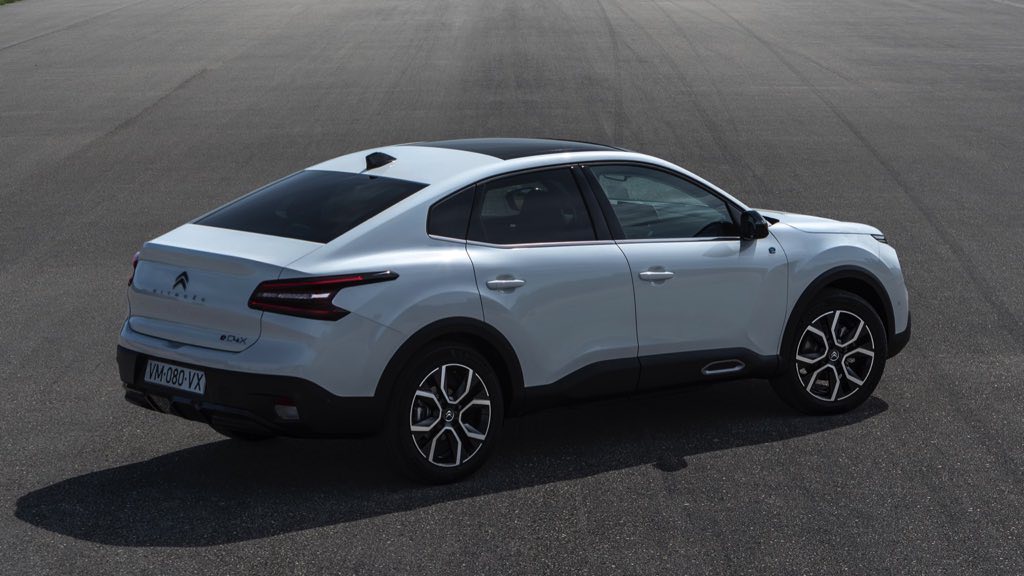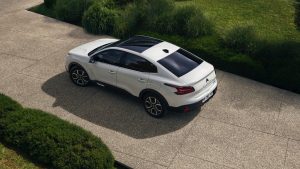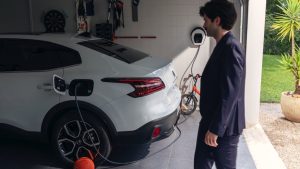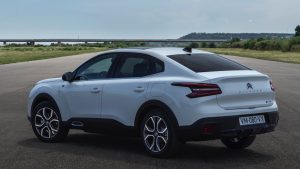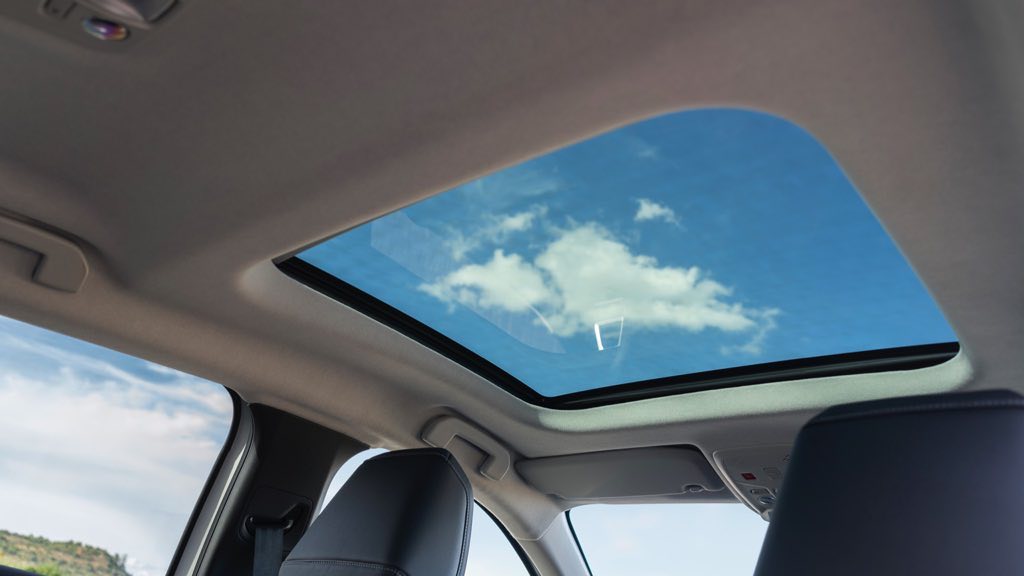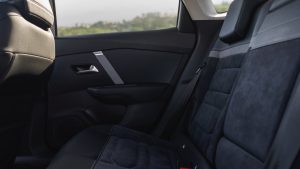Citroen e-C4 X
The Citroen e-C4 is an electric compact crossover SUV produced by the French automobile manufacturer Citroen. It was introduced in 2020 and is based on the third-generation Citroen C4. The “e” in the name stands for electric, and the “X” denotes its crossover styling.
The e-C4 is powered by an electric motor that delivers 100 kW (134 horsepower) and 260 Nm of torque. It has a range of up t 270 km on a single charge, according to the WLTP test cycle. It can be charged using a standard household socket, a public charging station, or a dedicated wall box. With a fast charger, it can be recharged to 80% in just 30 minutes.
The e-C4 has a sleek and modern design, with a panoramic sunroof, LED lights, and a unique front grille. It also has a spacious interior with advanced features such as a 10-inch touchscreen display, a digital instrument cluster, and advanced safety and driver assistance systems.
Overall, the Citroen e-C4 X is a stylish and practical electric car that offers a good balance of performance, range, and features.
| Performance | |
| Acceleration 0 – 100 km/h | 9.7 sec |
| Top Speed | 150 km/h |
| Electric Range | 270 km |
| Total Power | 100 kW (136 PS) |
| Total Torque | 260 Nm |
| Drive | Front |
| Battery and Charging | |
| Battery Capacity | 50.0 kWh |
| Battery Useable | 45.0 kWh |
| Europe | |
| Charge Port | Type 2 |
| Port Location | Left Side – Rear |
| Charge Power | 7.4 kW AC |
| Charge Time (0->270 km) | 7h15m |
| Charge Speed | 38 km/h |
| Fastcharge Port | CCS |
| FC Port Location | Left Side – Rear |
| Fastcharge Power (max) | 101 kW DC |
| Fastcharge Time (27->216 km) | 26 min |
| Fastcharge Speed | 430 km/h |
| Energy Consumption | |
| EVDB Real Range | |
| Range | 270 km |
| Vehicle Consumption | 167 Wh/km |
| CO2 Emissions | 0 g/km |
| Vehicle Fuel Equivalent | 1.9 l/100km |
| WLTP Ratings | |
| Range | 360 km |
| Rated Consumption | No Data |
| Vehicle Consumption | 125 Wh/km |
| CO2 Emissions | 0 g/km |
| Rated Fuel Equivalent | No Data |
| Vehicle Fuel Equivalent | 1.4 l/100km |
|
Rated = official figures as published by manufacturer. Rated consumption and fuel equivalency figures include charging losses.
|
|
|
Vehicle = calculated battery energy consumption used by the vehicle for propulsion and on-board systems.
|
|
| Real Energy Consumption Estimation between 111 – 237 Wh/km | |
| City – Cold Weather | 170 Wh/km |
| Highway – Cold Weather | 237 Wh/km |
| Combined – Cold Weather | 200 Wh/km |
| City – Mild Weather | 111 Wh/km |
| Highway – Mild Weather | 184 Wh/km |
| Combined – Mild Weather | 145 Wh/km |
|
Energy use for each trip will vary considerably depending on the driver and the conditions. Therefore, we have provided a range of estimates which can be useful in developing an understanding of the potential benefits of this technology.
|
|
| Dimensions and Weight | |
| Length | 4600 mm |
| Width | 1800 mm |
| Width with mirrors | 2032 mm |
| Height | 1525 mm |
| Wheelbase | 2670 mm |
| Weight Unladen (EU) | 1600 kg |
| Gross Vehicle Weight (GVWR) | No Data |
| Max. Payload | No Data |
| Cargo Volume | 510 L |
| Cargo Volume Max | No Data |
| Cargo Volume Frunk | 0 L |
| Roof Load | 0 kg |
| Tow Hitch Possible | No |
| Towing Weight Unbraked | 0 kg |
| Towing Weight Braked | 0 kg |
| Vertical Load Max | 0 kg |
| Miscellaneous | |
| Seats | 5 people |
| Isofix | Yes, 2 seats |
| Turning Circle | 10.9 m |
| Platform | PSA eCMP |
| Car Body | Liftback Sedan |
| Segment | JC – Medium |
| Roof Rails | No |
| EV Dedicated Platform | No |
Home and Destination Charging (0 -> 100%)
A public charging station is required to use the highest possible charging rate. The EVSE/charging station’s charging capacity affects how long it takes to fully charge the battery. The table below shows all possible options for fully charging the Citroen e-C4 X.
In Europe, plugging an electric car into an outlet is often as easy as plugging it into a household outlet, but there are differences from country to country. The table below shows the different ways to charge the Citroen e-C4 X, but in some countries some chargers may not be available.
Type 2 (Mennekes – IEC 62196)

| Charging Point | Max. Power | Power | Time | Rate |
|
Standard 7.4 kW On-Board Charger
|
||||
| Wall Plug (2.3 kW) | 230V / 1x10A | 2.3 kW | 23h15m | 12 km/h |
| 1-phase 16A (3.7 kW) | 230V / 1x16A | 3.7 kW | 14h30m | 19 km/h |
| 1-phase 32A (7.4 kW) | 230V / 1x32A | 7.4 kW | 7h15m | 37 km/h |
| 3-phase 16A (11 kW) | 230V / 1x16A | 3.7 kW | 14h30m | 19 km/h |
| 3-phase 32A (22 kW) | 230V / 1x32A | 7.4 kW | 7h15m | 37 km/h |
|
Optional 11.0kW On-Board Charger
|
||||
| Wall Plug (2.3 kW) | 230V / 1x10A | 2.3 kW | 23h15m | 12 km/h |
| 1-phase 16A (3.7 kW) | 230V / 1x16A | 3.7 kW | 14h30m | 19 km/h |
| 1-phase 32A (7.4 kW) | 230V / 1x32A | 7.4 kW | 7h15m | 37 km/h |
| 3-phase 16A (11 kW) | 400V / 3x16A | 11 kW | 5 hours | 54 km/h |
| 3-phase 32A (22 kW) | 400V / 3x16A | 11 kW | 5 hours | 54 km/h |
ast Charging (10 -> 80%)
If you want to enjoy driving an electric car, one of the most important features to consider is the number of miles per hour the car can travel while charged. This is called the “range” of the car. All electric cars have a certain range, even if they are 100% charged. This is because they do not have an internal combustion engine to lean on if you need to drive a long distance.
Max. Power: The maximum power provided by the charging point
Avg. Power: The average power provided by the charging point during a session of 10% to 80%.
Time: the time it takes to charge from 10% to 80%
Speed: the average charging rate during the session of 10% to 80%
Combined Charging System (CCS Combo 2)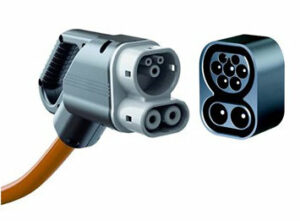
| Charging Point | Max. Power | Avg. Power | Time | Rate |
| CCS (50 kW DC) | 50 kW | 40 kW | 50 min | 220 km/h |
| CCS (100 kW DC) | 100 kW | 75 kW | 27 min | 420 km/h |
| CCS (150 kW DC) | 101 kW | 78 kW | 26 min | 430 km/h |
| Brand | Citroen |
| Model | e-C4 X |
| Body Style | Liftback Sedan |
| Car Engine | electric |
| Motor power | 100 |
| Maximum Torque, Nm | 260 |
| Battery Energy, kWh | 50.0 |
| Power reserve (NEDC/EPA/WLTP), km | - / - / 270 |
| Level Charging (230/400/DC), hours | 14.30 / 5.0 / 0.26 |
| Electrical Acceleration, 0-100 km/h (0-62.1 mph) in sec | 9.7 |
| Top Speed, km/h | 150 |















